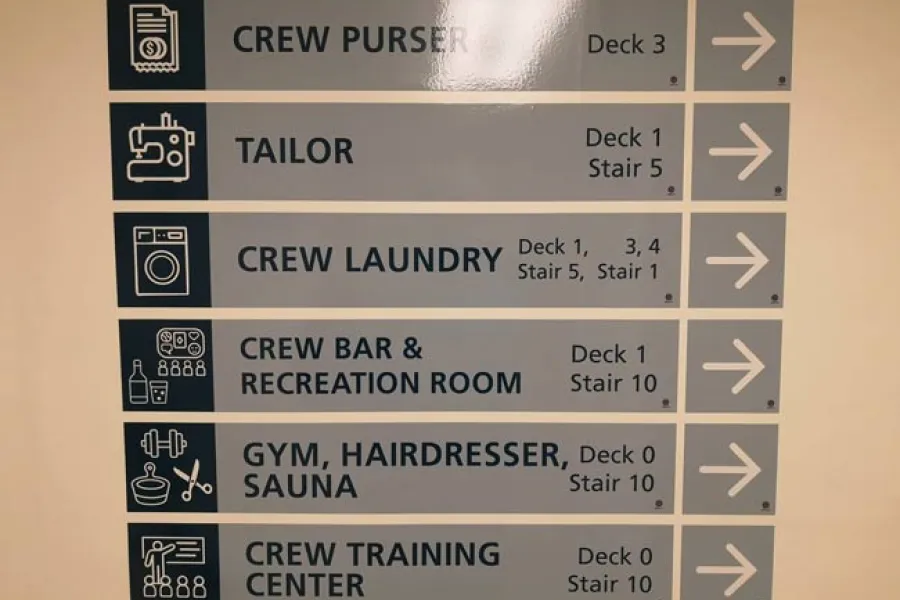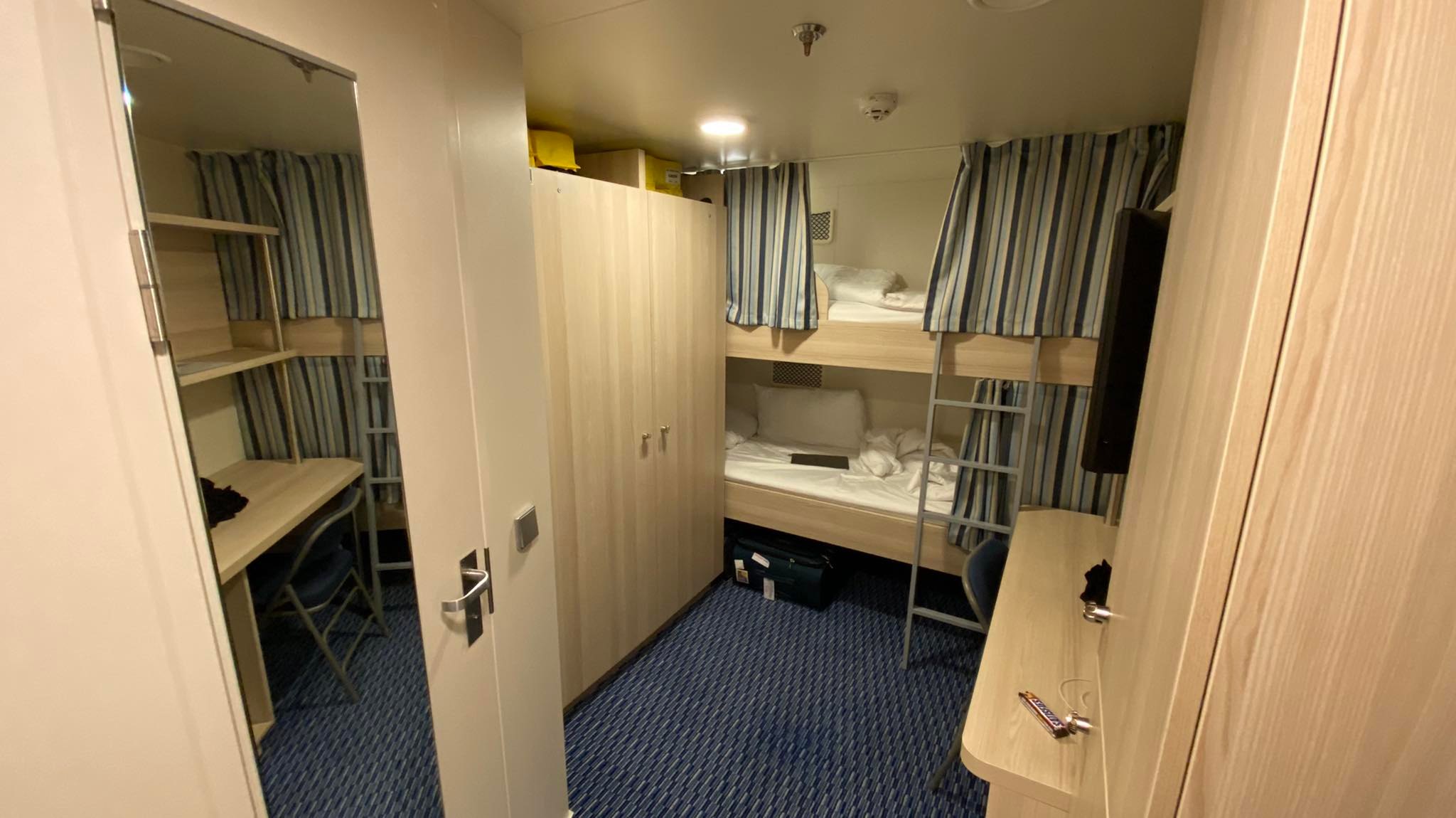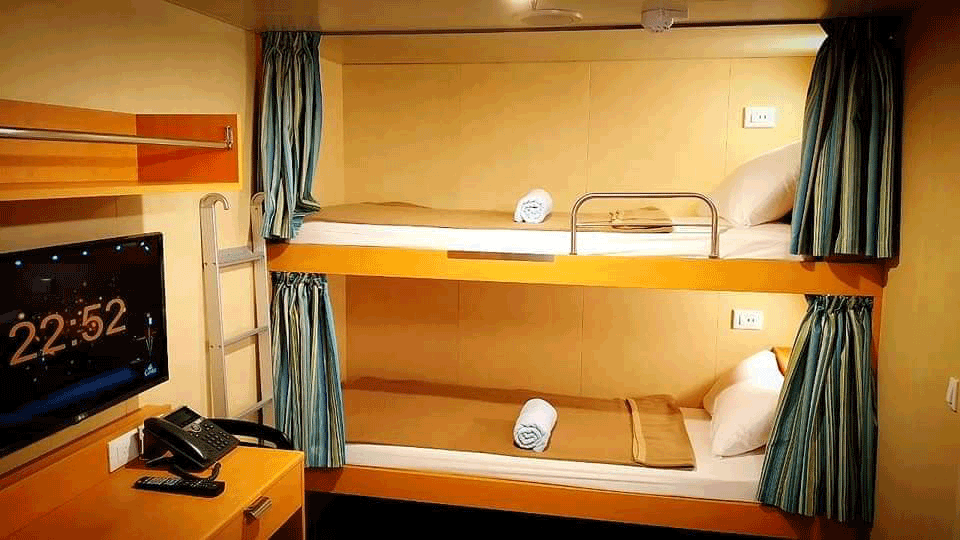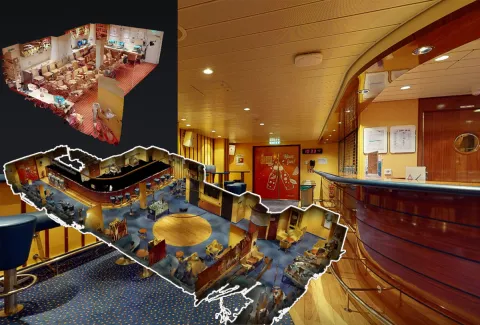
Crew members live onboard the cruise ship while fulfilling their work duties, and they are allocated in a dedicated section exclusively for their use. In certain instances, crew areas resemble areas accessible to guests, as some staff members and officers have guest privileges. However, not all staff members enjoy these privileges, prompting cruise lines to designate specific areas solely for the crew's use.
The extent of space dedicated to crew members varies, contingent upon the ship's size. Modern ships often feature enhanced facilities in the crew's designated region. Typically, the lowermost decks of many ships are exclusively designated for the crew.
Moreover, the lower decks serve as the primary location for crew cabins. It is not uncommon for these cabins to be situated below the waterline, and sharing a cabin with another crew member is a customary practice.

Crew areas are not easily accessible from guest areas, but they are all interconnected on their network of walkways.
Many ships have a prominent thoroughfare that runs the length of the cruise ship from bow to stern. On Royal Caribbean cruise ships or Carnival Cruise Line, this is often referred to as "I-95" because the large hallway reminded someone of the highway that runs up and down the east coast of the United States.
Up and down the corridor are essential notices and announcements pinned to the wall, so guests can quickly glance at them as they go about their day.
These corridors are ways to get around the ship and can also be temporary storage. Often luggage, garbage, and supplies are stored in these corridors until they can be moved elsewhere.
There are also elevators and stairwells reserved just for crew members.
Guests can sometimes glimpse these areas at the ship's medical facility or disembark on a gangway.

Depending on your rank or title, the cabin you get as a crew member will vary. Typically, two crew members share a cabin, although there can be more in a larger cabin.
Unlike guest staterooms, crew cabins are more practical. Almost instantly, you will notice fewer decorations and a smaller size compared to a guest room.
Bunkbeds are the usual type of bedding, as it allows for the maximum amount of space. Since these rooms are typically small, every square foot of space counts.
Some cruise ships add curtains to each bunk bed to provide more privacy for the crew.
Like a guest room, there is shelving, storage space, a television, a more excellent fridge, and a private bathroom.
For crew members that achieve a higher rank or title, that may mean a larger room, window, and arguably the best feature: not having to share the space.
The Crew Bar
When crew members are not working, they have a dedicated bar where they can relax.

Like guest bars, these are places for the crew to unwind and enjoy a cocktail or beer. They are usually less themed than guest bars, and often you will find mismatched furniture from other venues onboard.

You can find televisions, table games, or tables to relax at.
Crew parties are prevalent, and there can be themed nights at a bar to encourage extra fun for the crew.

Crew restaurant

When it's time to chow down, crew members have their restaurant onboard to enjoy all the necessary meals.
The crew mess is the name of the buffet-style restaurant crew members can dine at when off duty. The crew mess sometimes has prepared foods, ready-to-go foods, and ways to heat food brought in.

Just like the ship's buffet that guests experience, crew members line up and go through the line to take the food they want and then find a seat at an open table.
Just like guests, there are basic beverages for crew members, such as water, tea, or coffee. Soft drinks and alcohol will cost extra.

Staying healthy is as important to the crew as it is to passengers, and a unique fitness center is just for them.
Sometimes referred to as the weight room or gym, crew members can find free weights and even some machines to use so that they can exercise. The crew gym has fewer machines or frills than guest gyms, but some crew members with a higher rank can use the guest fitness center.

Life on a cruise ship is a unique and unforgettable experience, tough to compare to a land job. Only some jobs offer the chance to see many places worldwide, have exotic views, and meet many people from different countries. Obviously, after such experience, you'll become well-rounded and worldly and better understand global problems, people worldwide, and their culture and way of life.
Indeed, the only way to know if you like it is to try it. Nevertheless, I will expose some essential aspects of life on board to prevent doubts and uncertainties.
The Crew Cabins

These cabins, which are usually small, are located on decks under the passenger areas, and some of them are under the water line, which can be rather noisy due to the vibration and hum of the engine room and the splashing water. On the larger cruise ships, employees are separated by departments and, sometimes, by nationalities.
On some ships, you'll enjoy a cabin with a bathroom inside; on others, you'll have to be content with communal bathrooms shared by several crew members. The beds are bunk style. The cruise company provides the sheets, blankets, and pillows.

The crewmembers are responsible for the care, cleanliness, and proper maintenance of the cabins, and they must also keep them in due order. The ship's authorities regularly inspect the places to check them and ensure respect for the rules.
Privacy limitation is commonplace. Some posts allow a private cabin; new employees heading into an entry-level position must share a cabin with somebody. This is the only major issue on the cruise ships, but if you are okay with having a roommate, there is no problem.

The human relationships between roommates are an essential issue. The minor places increase possible personal differences. The successful operation of the ship depends on the cooperation of all the crew members. The potential individual differences require changes in lifestyles and a high team spirit. Issues such as order and cleanliness, smoking or non-smoking, nightlife, etc., must be solved friendly. If this system fails, the persons involved must go to the manager or supervisor. I experienced many cases while working on the ship when both of the employees involved in the fighting were sent home regardless of who started it or who was qualified for it.
Chances are you will only spend a little time in your cabin—just the time to sleep. And, finally, after some time working aboard, you could be promoted and get your cabin.
If your job title provides you with a single cabin, your life on board will become much more convenient and comfortable.

Crew Insights
Articles and experiences shared by crew members working on cruise ship. Find out more about ship life at sea together with tips and advices for first time crew members and cruise oldtimers.












